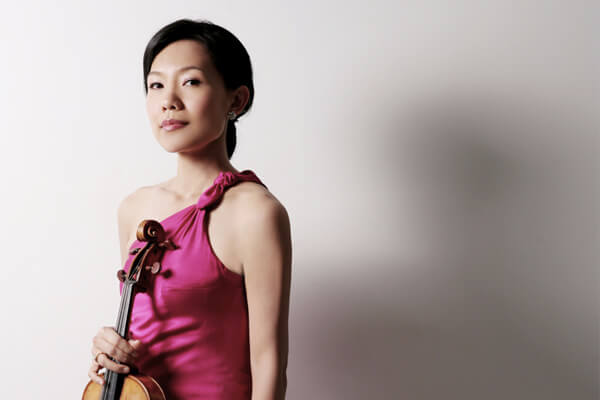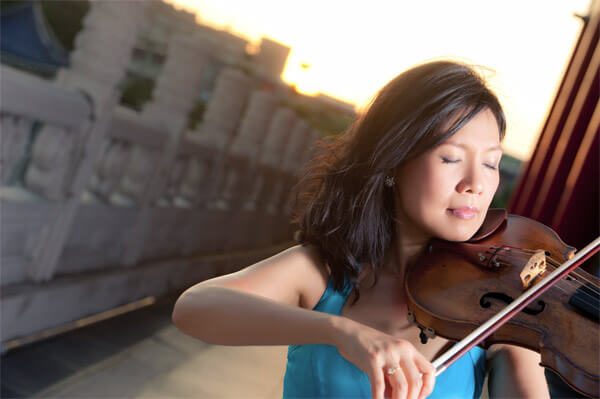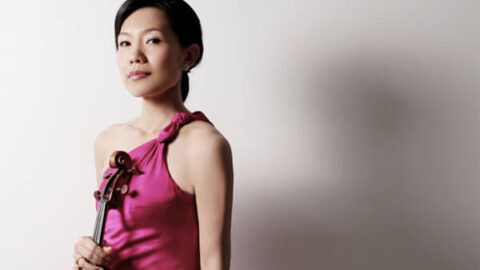On Monday, March 25, the American Modern Ensemble will present American Stories, a program of contemporary works inspired by diverse American stories, by living American composers. We asked 5 questions to Hsin-Yun Huang who will join the AME on the viola to perform pieces by David Ludwig and Steven Mackey.
For two of the pieces recorded on your latest release (Viola, Viola | Bridge records, 2012) you were involved in the commissioning process. How do you choose composers you commission pieces from?
The CD is the brainchild of a project for the last 10 or so years. I started by wanting to commission a composer I admired from my home country Taiwan, so I approached Shih-Hui Chen whom I met while performing with Da Camera in Houston. Steven Mackey is a composer I got to know while in the Borromeo Quartet and was always fascinated by how his “roots” and his language have such personality and are totally unique. Since most of the viola repertoire is on the more serious side, we decided that it would be cool to have a piece that had more of a rock or jazz influence. Then while the recording project was coming together, I thought I needed a simple viola and piano piece to contrast with all the other pieces (they are all of different combination and sonority). The presidents of Bridge Record, David and Becky Starobin introduced Poul Ruders’ music to me. I was immediately taken with his imagination and color. Hence the Romances for Viola and Piano.

What are looking for in a new piece?
I think a composer should be allowed to write in any way they like. I suppose mostly I look forward to being surprised. To be taken places that I don’t expect. That’s the beauty of a commission. Then the learning process is just the same as you would to learn a Beethoven Quartet. There is definitely the beginning phase, then getting to know it better and finally feeling like you can really speak the language. So it is always a privilege to be able to play something new several times.
Even though you received an outstanding education (Yehudi Menuhin School, Curtis, Juilliard), and looking back at the early years of your career, is there anything you wished you had been taught? Does it influence the way you teach?
That’s a fascinating question. To tell you the truth I wish I could have gone to a university and spent four years with a different focus. Of course I loved my schools and have been very fortunate to experience extraordinary musicians in my life. Had my family been in a situation where they were able to support my going to a university, I would have loved that.
When it comes to my own teaching style, it is so difficult for one to have a clear sense of who you are as a teacher. For sure, the more I teach the more I feel I need to “feed” on inspirations; whether it’s coming from musicians I collaborate with, or coming from reading and getting to know new pieces. What I try to do (and hope that I am somewhat successful at it) is to try to put things in perspective without losing the integrity or the expression on details. But more often I am just in awe of what the students can already offer and how different they can be. I hope I am a different teacher to each individual student.

Can you tell us more about the program on March 25?
AME is an exciting group to see and hear. I know there are so many contemporary groups performing music of today but I am always excited when surrounded by living composers and their music. The program on March 25 centers on the idea of “American” music with some unique and fresh voices of America today. The pieces I know well and that we are performing on the program are David Ludwig’s Flower in the Desert and Steven Mackey’s Groundswell. Flower in the Desert was, in fact, written for me and clarinetist David Shifrin and commissioned by the Lake Champlain Chamber Music Festival. So I was there at the first performance, it is a piece inspired by quite a horrible story from the local news. David Ludwig will talk more about the piece at the performance. Steven Mackey’s Groundswell is a piece that Steve was working on while on his honeymoon in Italy. Some of the main musical material is trying to capture the sound of Italian to a foreigner; woven throughout are sounds of the vespas and radio. The entire piece is in seven movements and has the shape of a large arch that connects between the movements. The titles of the movements suggest a journey going up to the mountain top, then coming back down—Steven Mackey began his career as an incredible freestyle skier. The fourth movement is the center of the piece, and is also the most austere. It’s a large work for viola and one that is unbelievably exciting to perform.
Have you ever worked with the American Modern Ensemble? If so can you tell us more about previous collaborations?
I was first introduced to the group through Steven Mackey. We performed Groundswell together a few years back in Princeton where Steven teaches. I had done this piece with several other groups before but with the American Modern Ensemble it was so easy and we hit it off right away. Mackey’s music is not straight forward and he has a wonderful relationship with them as well. So all of this makes this collaboration a total joy because there is a great sense of trust and fun. When the opportunity of making a recording presented itself, I immediately asked AME to be my partner.
For more information, visit: http://americanmodernensemble.org | http://www.hsinyun.com
























